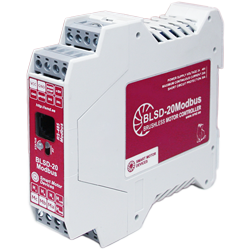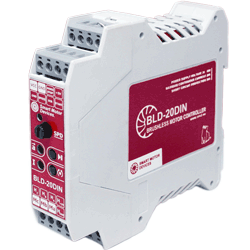According to statistics compiled by Smart Motor Devices, low‑power DC brushless motors are one of the most common and effective drives for solving speed and position control tasks for non‑precision systems.
Our company's developers continuously monitor trends in the use of such drives and are constantly working both on creating new devices and improving existing models.

Redesign of the controller BLD‑20DIN for DC brushless motors
By the fall of 2023, Smart Motor Devices has updated the design and firmware of one of its most popular devices, the BLD‑20DIN speed controller.
Even for simple speed control systems, additional functionality must be provided to fully integrate the drive into the system. BLD‑20DIN contains all the functions necessary and in demand for such devices.
The updated model has retained the same dimensions and appearance, is fully interchangeable with the previous version, but at the same time has received a number of useful changes. First of all, a more powerful radiator was added to the case. This makes the controller more resistant to possible overheating and adverse operating conditions.
The protection and current limiting circuit has also been updated. Among other things, current sensors and algorithms for calculating currents in phases for various motion parameters have been changed.
The braking circuit has undergone a complete change. Although the use of external braking resistors is not common for such low‑power drives, we still provide the possibility of connecting them to expand the possible operating modes and areas of use of our controllers.
BLD‑20DIN functionality and features
The BLD‑20DIN has been designed to operate with three‑phase DC brushless motors with Hall sensors.
BLD‑20DIN provides the following functions and capabilities:
- Speed regulation;
- Smooth, adjustable acceleration and deceleration;
- Limiting the maximum current and output torque of the motor to protect both the motor itself and the surrounding mechanics;
- Adding security features;
- Additional discrete inputs for motion control;
- Possibility of connecting an external braking resistor.
Speed control in BLD‑20DIN controllers is implemented using an analog voltage signal. The motor speed is proportional to the input analog signal 0 to 5V.
For more efficient control of motors with different output parameters, the controller provides scalability - a full range of speed control with an analog signal is available for both motors with relatively low speeds (nominal value up to 1000 rpm), and for high‑speed models (with rated speed up to 20000 rpm).
In addition to the analog voltage signal, the BLD‑20DIN controllers provide speed control with a built‑in potentiometer. This feature is in demand for test runs of the drive and is useful for applications where the speed is adjusted once and does not change during operation - this allows reducing the costs of additional system elements.
Smooth acceleration and deceleration in BLD‑20DIN is determined by the position of the trimming resistor on the front panel of the controller.
The maximum current limit is set in the range from 1A to 20A. This allows to safely use BLD‑20DIN controllers with motors of different power without the risk of damage due to overload. The updated model has an improved algorithm for setting and limiting current for various motion parameters.
To implement the safety function on the user side the controller has a special discrete input HARD_STOP. During normal operation of the system, there is a signal at the input (closed to the GND terminal of the controller). In the event of an accident, the HARD_STOP connection circuit is open and the controller immediately stops the motor and turns into emergency mode.
Connecting an external braking resistor allows to suppress regenerative energy when working with inertial loads, long braking or forced rotation of the motor shaft.
For correct operation of the controller with motors from different manufacturers, we have provided the ability to configure the range of operating speeds, the number of poles, and the direction of counting Hall sensor pulses.
Final result
As a result, Smart Motor Devices offers excellent models to control BLDC motors, which are:
- cost‑effective;
- user‑friendly and easy to use;
- full‑functional for motion control;
- equipped with protection and a reliable device.

